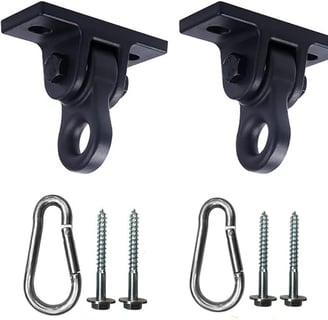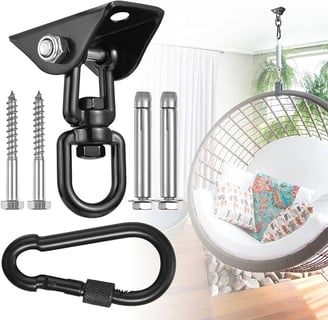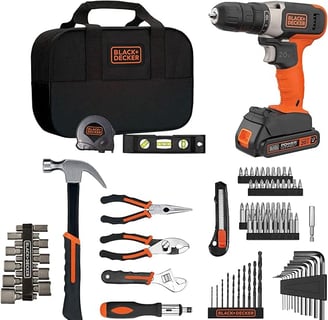How to Hang Objects from the Ceiling
8 min read


Understanding Load-Bearing Walls and Ceilings
In architecture and construction, load-bearing walls and ceilings play a crucial role in maintaining the integrity of a building's structure. A load-bearing wall is designed to support both its own weight and the weight of any loads applied to it, such as ceilings, upper floors, and sometimes roofs. These walls are integral to the stability of a structure, unlike non-load-bearing walls, which merely serve to divide spaces without providing structural support.
Identifying load-bearing elements within a building can be complex, particularly in older structures where modifications may have been made over time. A common method to determine whether a wall is load-bearing is to inspect the building's layout. Typically, walls that run parallel to the floor joists are non-load-bearing, while those running perpendicular are often load-bearing. Additionally, walls aligned with a beam in the ceiling below or those that directly support the floor above tend to be load-bearing.
Another critical aspect to consider is the ceiling itself. In many cases, ceilings can also be load-bearing, especially in structures where heavy fixtures, such as lighting or heavy objects, are hung. Understanding the distinction between load-bearing and non-load-bearing components is essential for anyone planning to hang heavy items from the ceiling. Misjudging which ceilings can support substantial weight can lead to catastrophic failures, resulting in property damage or even injury.
Therefore, when preparing to hang heavy objects, it is vital to assess the load-bearing capacities of walls and ceilings in your space. Consulting with a structural engineer or contractor can provide valuable insights into the safest methods for securing heavy items, ensuring that your approach is both effective and safe.
Choosing the Right Hardware for Hanging Objects
When it comes to hanging heavy objects from the ceiling, selecting the appropriate hardware is essential to ensure both safety and stability. Various types of hardware can be utilized, including hooks, anchors, and brackets, each having its own specifications and weight limits. Understanding these options will help in choosing the right equipment tailored to the weight of the item and the nature of the ceiling material.
Hooks are one of the most common types of hardware used for hanging heavy objects. They generally have a straightforward design, which allows for easy installation. However, the weight capacity of hooks can vary significantly based on their construction material and design. For instance, metal hooks are often rated for heavier loads compared to plastic ones. It is crucial to select hooks that explicitly state their weight limit, ideally exceeding the object's weight by a reasonable margin for safety.
Another option is the use of anchors, which are particularly beneficial when attaching heavy items to drywall or hollow ceilings. There are various types of anchors available, such as toggle bolts and molly bolts. Toggle bolts provide excellent support for heavy objects, while molly bolts are suitable for moderate loads. It is advisable to consult the manufacturer’s guidelines to understand the carrying capacity of each type of anchor.
Brackets serve as a robust solution for particularly heavy or bulky items, offering strong support by distributing the weight across several points. The installation of brackets often requires screws and may involve additional drilling into the ceiling. Like hooks and anchors, it's important to determine the weight limitations of brackets based on their size, material, and design. When making a choice, consider both the weight of the object and the structural integrity of the ceiling material to ensure secure and lasting installations.
Tools You Will Need for the Job
Hanging heavy objects from the ceiling requires a thoughtful selection of tools to ensure both safety and effectiveness. The types of tools you will need can be categorized into manual tools, power tools, and safety equipment, each playing a vital role in the hanging process.
Starting with manual tools, a sturdy screwdriver is essential for securing hardware. Depending on the type of fasteners you use, either a flathead or Phillips screwdriver can be appropriate. A hammer is another helpful manual tool, particularly when dealing with anchors or toggles that may require a firm tap. Additionally, a measuring tape will help ensure that your heavy objects are hung at the desired height and level.
When it comes to power tools, a drill is probably the most significant tool in your arsenal. A cordless drill can facilitate the installation of screws or anchors with just a pull of the trigger, offering efficiency while saving time. If you are working with ceiling joists, a stud finder is indispensable; this tool helps locate the hidden structure in the ceiling, ensuring that heavy objects are anchored securely. Misjudging the placement can lead to potential safety hazards, making the stud finder a critical component in your toolkit.
It is also vital to consider safety equipment; a hard hat and safety goggles should be worn to protect against falling debris. If you are using a ladder, it is crucial to have anti-slip shoes and ensure the ladder is stable. Lastly, investing in high-quality tools cannot be overstated. Quality tools not only last longer but also contribute to safer and more efficient work, minimizing the risk of accidents that may arise from using inferior equipment.
Locating Studs and Securing Anchors
When planning to hang heavy objects from the ceiling, it is crucial to locate the ceiling studs accurately and secure anchors effectively. Ceiling studs provide the necessary support and strength to hold substantial weight safely. A stud finder is a valuable tool for this task, as it can detect the wooden or metal framing behind the drywall. Typically, ceiling studs are spaced either 16 or 24 inches apart, so understanding this spacing is essential for effective placement.
To utilize a stud finder, begin by sweeping it slowly across the ceiling, maintaining it in a horizontal position. The device will indicate the presence of a stud by signaling or lighting up, which allows the user to pinpoint the exact location. Once a stud is located, it is advisable to mark its position with a pencil to ensure accuracy during the anchor installation process. Additionally, measuring distances from the nearest wall helps confirm the location of adjacent studs and ensures that the heavy object will be secured between them, providing stability.
Securing the anchors is the next critical step in ensuring that heavy items are safely affixed to the ceiling. Depending on the weight of the object, different types of anchors may be employed, such as toggle bolts, molly bolts, or eye bolts. It is essential to choose anchors that are rated for the weight you intend to hang. When installing these anchors, drill pilot holes into the marked stud locations, ensuring that the installed hardware is adequately aligned and tightened. Failing to do so can lead to accidents, making it imperative to follow these installation guidelines comprehensively.
Installation Process: Step-by-Step Guide
Hanging heavy objects from the ceiling requires careful planning and execution to ensure safety and durability. The first step involves gathering all necessary tools and materials, including a stud finder, a drill, appropriate anchors or hooks, a measuring tape, a level, and a ladder. Before starting, assess the weight of the object to determine the correct support system. This is crucial for selecting the right type of anchors, as inadequate support can lead to accidents.
Next, use the stud finder to locate the ceiling joists. These joists are the structural beams that will support the weight of the object. Mark their positions with a pencil. Once marked, measure the distance between the marks to ensure that your heavy object will be evenly supported. Accurate measurements are essential for the installation’s success. If your object spans multiple joists, make sure to measure twice to avoid errors.
After determining the locations, it is essential to drill pilot holes into the joists for the anchors or hooks. The pilot holes should be drilled based on the specifications of the chosen anchors, ensuring that they fit snugly. Utilizing a level at this stage will help ensure that the heavy object will hang straight and secure. This is particularly important if the object is visually prominent in the room.
Once the pilot holes are drilled, insert the anchors or hooks into the holes. Firmly tighten them according to the manufacturer's guidelines, as this will significantly contribute to their holding capability. Finally, attach the heavy object to the installed anchors or hooks, ensuring it is secure before putting any weight on it. Always perform a final check to confirm everything is firmly in place. Following these steps will guarantee a safe and sturdy installation of heavy objects from the ceiling.
Safety Precautions to Keep in Mind
When embarking on the task of hanging heavy objects from the ceiling, it is essential to prioritize safety to prevent potential accidents and injuries. The first precaution is to always wear appropriate protective gear. This includes safety goggles to protect your eyes from falling debris, gloves to ensure a firm grip on the heavy item, and a hard hat to guard against head injuries. Additionally, using a sturdy harness when working at significant heights can further enhance personal safety.
Before starting this task, it is crucial to ensure that the work area is clear of any hazards. Take the time to remove obstacles that may impede movement or increase the risk of tripping. Move any furniture or decorative items away from the vicinity where you intend to work to avoid damaging them or causing injury in case of an accidental drop. Having a clean, organized environment not only promotes safety but also contributes to a more efficient workflow.
Moreover, understanding the weight limits of both the hanging object and the ceiling structure is imperative. Consult structural guidelines or an expert if you're uncertain about the weight capacity of beams or hooks to be used. Overloading these components can lead to catastrophic failures, resulting in damage to property and posing significant safety risks. It is advisable to use appropriately rated hardware designed for heavy-duty applications. Reinforcing the ceiling with additional support may be necessary, particularly for objects that exceed moderate weight limits.
In summary, adhering to safety precautions, which include protective gear, a clear workspace, and knowledge of weight limits, greatly reduces the risk of accidents while hanging heavy objects from the ceiling. By prioritizing these measures, individuals can ensure a safer and more successful installation process.
Maintenance and Checks for Longevity
Ensuring the safety and strength of heavy objects suspended from the ceiling necessitates continuous maintenance and regular checks. Over time, even the most durable hanging hardware can experience wear and fatigue, thus compromising the structural integrity of the installation. It is essential to routinely inspect both the hardware and the suspended objects themselves to identify any signs of damage that could pose safety risks.
Start by examining the mounting brackets, hooks, and chains for any signs of corrosion, bending, or fraying. Metal components that show rust or deterioration should be replaced promptly as they can significantly weaken under stress. Similarly, load-bearing components should be evaluated for any signs of fatigue or deformation, which can indicate that they are no longer capable of supporting the weight effectively. If you notice any abnormalities, it is critical to address them immediately, as neglecting these issues can lead to severe accidents.
In addition to hardware inspections, the suspended object itself must also be evaluated regularly. Ensure that it remains securely attached and is free of cracks or breaks that could affect its stability. For items that are subjected to frequent movement or vibrations, consider evaluating them more often than those that remain stationary. A good practice is to create a maintenance schedule and incorporate it into your routine, allowing for systematic checks every few months.
Furthermore, keeping a record of these inspections can be beneficial. Documenting the condition of both the hardware and hanging objects provides insights into how often replacements are needed and helps maintain overall safety. By prioritizing ongoing maintenance and checks, you can enhance the longevity of your ceiling installations while ensuring they remain safe and reliable over time.











